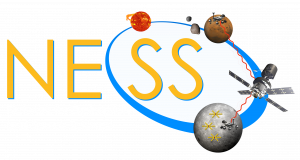The First Stars
About 75 million years after the Big Bang, massive gas clouds formed inside dark matter clumps and subsequently condensed into the first stars in the Universe. These stars - likely much more massive than our own - illuminated the Universe in the Cosmic Dawn.
Image: An artist's conception of a blue giant, a star similar to those in the Cosmic Dawn.
Credit: NASA's Goddard Space Flight Center/S. Wiessinger
The First Black Holes
Because they were likely so massive, the first stars could live only a few million years - after which many likely collapsed and formed the first black holes in the Universe. These black holes seeded some of the most powerful light sources that ever existed.
Image: An artist's conception of the most primitive supermassive black holes known, at the core of a young, star-rich galaxy.
Credit: JPL
Light Fills the Universe
As the first light sources grew during the Cosmic Dawn, their light penetrated even the most distant and isolated regions of the Universe, where it influenced both the tenuous gas outside of dark matter clumps and the gas clouds within it, as they tried to form stars.
Image: A modern example of a star affecting other stars, but instead of just radiation, with an actual wave of gas.
Credit: NASA/JPL-Caltech
The Spin-Flip Background
During this early era, only a tiny fraction of the Universe’s matter is actually inside of stars - the vast majority is a tenuous hydrogen gas spread throughout the Universe. To see this gas - and to use it to learn about the sources illuminating the Cosmic Dawn - astronomers hope to use the spin-flip background generated by the hydrogen.
Image: A computer simulation of the end of the Cosmic Dawn as could be seen in the spin-flip background. The blue shows the brightness of the background, while the black are regions that have been ionized so do not produce a spin-flip background.
Credit: Andrei Mesinger



